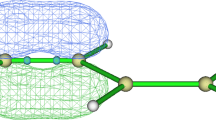Summary
It is well known that many molecular properties are strongly dependent on internal nuclear arrangements. Two possible, independent approaches can be followed while studying changes in molecular characteristics as functions of the nuclear geometry. These are the analysis of potential energy surfaces and the analysis of molecular shape. In this work, we seek to establish relationships between potential energy maps and shape invariance region maps, where each point of these maps represents a nuclear configuration. The study is performed by analyzing the occurrence and lack of certain symmetries in both types of maps. As illustrative examples, we consider the three structural isomers of the dihydroxybenzene molecule. Potential energy is computed at the STO-3G ab initio level, while the shape is described by the shape group method as applied to fused-sphere van der Waals surfaces. It is shown that the symmetry of the shape invariance maps follows closely, but not exactly, the symmetry of potential energy surfaces. The molecular surface is thus “blind” to some small changes of the potential (a feature to be expected to hold also for molecular surfaces defined in terms of electronic charge density). Our findings suggest that a crude fused-sphere model may suffice to describe some of the structural changes in molecular surfaces, as well as their relationships to the electronic energy.
Similar content being viewed by others
References
Pullman B (1976) Quantum mechanics of molecular conformations. Wiley, London
Mezey PG (1987) Potential energy hypersurfaces. Elsevier, Amsterdam
Sanathanan L, Danaher E, Kim K-H, Martin YC (1987) J Comput Chem 8:1075
Richards WG (1983) Quantum Pharmacology. Butterworths, London
Kier LB, Hall LH (1986) Molecular connectivity in structure-activity analysis. Research Studies Press, Letchworth, UK
Franke R (1984) Theoretical drug design. Pharmacochemistry library, vol 7. Elsevier, Amsterdam
Randic M (1988) Int J Quantum Chem QBS 15:201; Randic M personal communication, 1989
Mezey PG (1986) Int J Quantum Chem QBS 12:113
Mezey PG (1987) J Comput Chem 8:462
Arteca GA, Mezey PG (1988) J Comput Chem 9:554
Arteca GA, Mezey PG (1987) Int J Quantum Chem QBS 14:133
Arteca GA, Mezey PG (1988) Int J Quantum Chem QBS 15:33
Arteca GA, Mezey PG (1989) J Phys Chem 93:4746
Francl MM, Hout RF, Hehre WJ (1984) J Am Chem Soc 106:563
Frisch MJ, Binkley JS, Schlegel HB, Raghavachari K, Melius CF, Martin RL, Stewart JJP, Bobrowicz FW, Rohlfing CM, Kahn LR, Defrees DJ, Seeger R, Whiteside RA, Fox, DJ, Fleuder EM, Pople JA (1984) Gaussian 86, Carnegie-Mellon Quantum Chemistry Publishing Unit, Pittsburgh
Vázquez, Ríos MA (1988) Mol Phys 65:129
Arteca GA, Mezey PG, Int J Quantum Chem, in press
Gavezzotti A (1983) J Am Chem Soc 105:5220
Munkres JR (1984) Elements of algebraic topology. Addison-Wesley, Menlo Park
Mezey PG (1988) J Math Chem 2:299.
These features were overlooked in [12], where the points were wrongly classified as minima
Woolley RG (1976) Adv Phys 25:27
Mezey PG, Maruani J (1989) Mol Phys, in press
Author information
Authors and Affiliations
Rights and permissions
About this article
Cite this article
Arteca, G.A., Heal, G.A. & Mezey, P.G. Comparison of potential energy maps and molecular shape invariance maps for two-dimensional conformational problems. Theoret. Chim. Acta 76, 377–390 (1990). https://doi.org/10.1007/BF00528878
Received:
Revised:
Accepted:
Issue Date:
DOI: https://doi.org/10.1007/BF00528878




